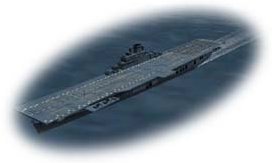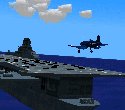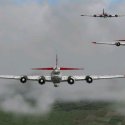The Arctic Storm "11th Air Force" | home
Do you have the right stuff | Training | Trash Attack
Trash Attack
A CV requires a minimum of 9,000 pounds of bombs to be sunk
For the benefit of the Knights
This document could be detrimental to the Knight cause if disseminated carelessly. Please take care to prevent the information contained from being used against the Knights.
These instructions assume:
The pilot knows how to correctly calibrate his bombsights. Contrary to common perception, near pinpoint accuracy with bombsights is currently possible from heights even in the 20k range.
Basic attack agenda:
To place enough ordinance onto a Flattop to sink it using a single pilot on a single run, and to be able to do this amidst moderate resistance, and even to land the flight after success.

Attack Theory:
CV anti-aircraft defenses are relatively ineffective at 4k or higher. A CV requires a minimum of 9,000 pounds of bombs to be sunk. The only aircraft capable of carrying the required ordinance are limited to the bomber groups, B17, Lancaster, B26, etc. No single aircraft can carry sufficient ordinance to sink a CV. Most attacks using bomber-groups are attempted at very low altitude, for the sake of accuracy and out of fear of evasive maneuver by the CV group. These attacks expose the aircraft to lethal anti-aircraft fire, such that even if the attack can be carried to the CV, the attacker will surely be downed, the attack is suicidal at it's outset. However, this attack can succeed if attempted at an altitude of 4k or higher with a very reasonable chance of aircraft survivability.
So how do you successfully attack the CV from 4k in altitude and achieve a 90% or greater success rate?


Follow these instructions:
1. Select B26's with the 4x1000 bomb load (DO NOT USE THE 500 pounders or ANY OTHER BOMBLOAD) and 25% fuel (more if the distance is 3 grids or more away from your originating base). If you use a different bomb load and your attack fails, kick yourself for being an idiot. If you take 50% fuel, it will take you an extra 2 minutes or so to reach effective altitude.
2. Climb to an altitude of 5500 feet or greater. I like to climb in the B-26's at 175 - 200 mph. The desired altitude can be reached in roughly 4.5 minutes.
3. Point the aircraft directly at the CV group and put into a -2000 ft VSI dive until the speed is at 262 mph on the dial. Once you reach 262 mph, put the flight into level flight autopilot. The flight should be right about 4k in altitude and at 262, it is max level flight speed at 4k (roughly 260 at 5k, 258 at 6k, 255 at 8k, 252 at 9k).
4. Calibrate bombsight and refine the vector of the flight to pass the crosshairs 1/2 CV length in front of the CV. The correct salvo is all four bombs (a total of 12k bomb-weight), and a delay of .1 second. I have very extensively tested this salvo/delay resolution; you will have excellent success with it. If your attack fails and you have used a different salvo/delay, kick yourself for being an idiot.
5. Bombs Away. The correct aiming point is EXACTLY 1/2 CV ship length DIRECTLY in front of the CV, even if it is turning. This is the correct aim point if the flight is anywhere from 4k to 7k in altitude. The bombs should hit amidships. The bombs WILL hit their mark even if the CV is in a turn (The way a ship turns is by changing the ships direction by moving the REAR of the ship sideways, because of this, the CV cannot avoid the bomb-package by turning as it is not capable of a radical enough change in degree to do so). I use a full CV ship length from 7k - 11k in altitude. I rarely attempt bombing a CV group outside those altitude brackets.
6. Put your nose down and try to get to 295mph or so in speed and weave back and forth to avoid AA fire. You should have all three aircraft still and probably two will be smoking, but you should be a viable formation still, and should be able to make it back to base. Prepare to call out "CV dead" or some creative variation of those letters.
My success ratio:
I would put the attack ratio closer to 99% for success, based solely on the formula, but speaking on past history, I screw something up about 10% of the time (bomb-bay doors closed, waiting too long to adjust flight direction resulting in a wider bomb-dispersion, losing a bomber to defending fighters, etc.). I have made successful attacks from less than a grid of flight distance, as high as 11k, and as low as 3k (but I only had one smoking crate left after the 3k run). I have NOT been successful below 3k because you
lose one bird to defending AA before you reach bomb release, either by losing an engine and falling back in formation or outright explosion. The success rate drops dramatically above 7k however, due to CV maneuver and difficulty in aiming from so high (the perspective of the ship changes dramatically). On the plus side, occasionally I manage to kill the CV with only two birds in my flight. This may be due to the CV having prior damage, I don't know.
These instructions heavily suggest using the B-26 (My "Sharks"), but there is no reason the LANC or B-17 could not perform the same attack. The B26 is the fastest to altitude, fastest level flight, most maneuverable, and very defendable, therefore my first choice.
I am hoping I did not leave out some 'KEY' piece of information. It is actually pretty simple for attack instruction. It is a pattern that applies to any level-bomb attack, regardless of target.
Arctic Storm 11th Air force
Trash101